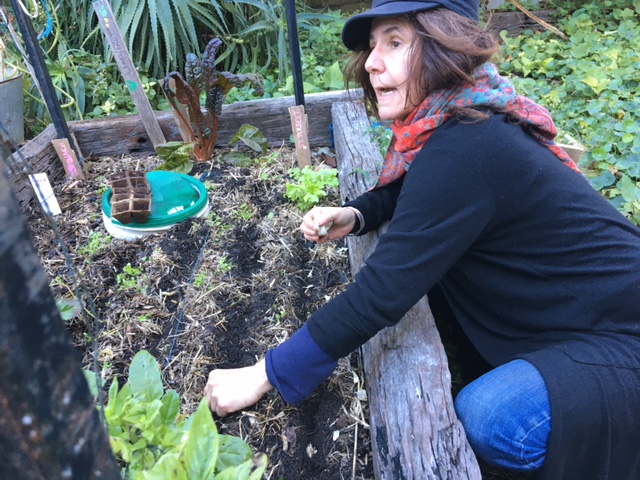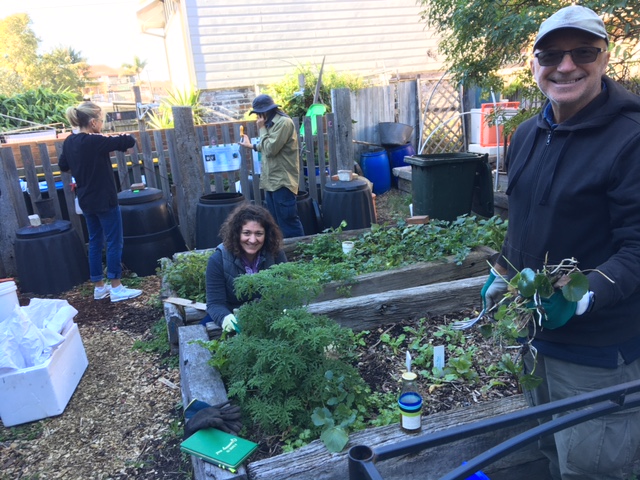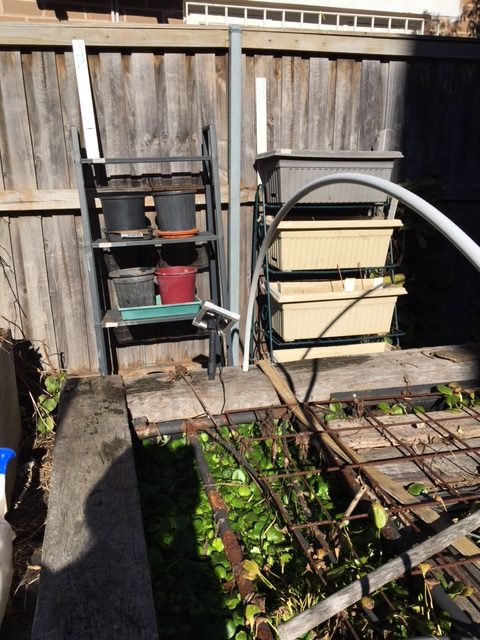Soil Winter Garden
Winter is a slow month in the garden; and our garden is overshadowed by a building – even more so in these cold months. However, I noticed recently – on a sunny day – that there’s a niche in the garden that gets a good dose of sun as the rays travel along a side alley to the garden at the back of our Landshare plot.
Any sized plot of land is just the place to learn about so much: soil, food production, making compost, permaculture principles, and in the case of Transition Bondi growing community. And though we’re nowhere near an urban farm, we can learn big, in our relatively small community garden.
Savour these words – mulch, compost, worms, microbes, bacteria, coffee husks, soil, mycelium. Earth is a rich substance, but did you know that topsoil is disappearing through erosion (by water and wind) as such a rate that it will be gone in 60 years?
In an interview on ABC radio recently I learned a lot about soil.
Matthew Evans has written a book called Soil – The incredible story of what keeps the Earth and us healthy.
SOIL is not dirt, it consists of sand, silt and clay, which make up the texture. This determines how water and air are held and travel through the soil. (Did you know that during floods, trees die from suffocation, because they can’t access air in the sodden soil?)
Another amazing factoid: 1 tsp soil contains 10 bn living things, more than the global human population. Earth is alive! With tiny things.
Worms we love, and find by the hundreds in good compost.
Microbes in soil affect weather – they become airborne into the atmosphere where water vapour condenses around small solid particles and creates rain.
Plants and soil are interdependent. Plants, in the presence of sunlight (photosysnthesis) and water convert Carbon into carbohydrates. Plants also need minerals to build their structures and reproduce, and they depend on the creatures in soil to ‘deliver’ them. In fact plants ‘signal’ what they need by way of minerals!
Likewise, microbes can’t create their own nutrients. They rely on plants to create sugars (and amino acids and other energy in digestible form. The plants exude sugar from their root tips, which bacteria, fungi, algae and other micro-organisms need.
Land practices in large scale agriculture are known to create damage, particularly through
cutting the soil (ploughing). Disturbance of the surface of the soil ruins the home of soil micro-organisms and mycelium (a web along which chemicals travel and connect trees) , and decomposition of soil life releases carbon into the atmosphere.
Since colonisation in Australia half of the topsoil has been lost. And it takes 1000k years to make 1cm soil; it is a finite resource. And given that 98% of our food comes from topsoil we need to take heed. It is predicted that at current rates, all our topsoil will be gone in 40 years time. ): We need to get to work to reverse this destruction.
Two other factoids: half of the antibiotics we use come from topsoil. And being around soil contributes to feelings of wellbeing.
What can we do as individuals? Every action counts, every person can make a contribution. Small-scale gardening, on window-sills, balconies and in laneways or on verges – these situations connect us to the larger questions about soil and land management. And the same information applies to soils in our potplants.
Every bit of soil counts and mulching the soil’s surface protects the life forms underground, maintains moisture, allows green cover and stops the release of carbon into the atmosphere.
Finally, composting is a powerful way to support good soils. Besides which it diverts food from landfill. Did you know that food buried in landfill (away from oxygen) produces methane, a greenhouse gas many times more concentrated than carbon dioxide?
Join us in our compost-making and land management practices on a small scale, at our community garden digs. Second Sunday of every month.




Thank you for this blog article summarizing a complex topic in a simple way!